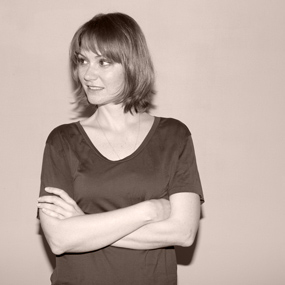Gabriel & Guillaume’s signature mélange debuts at Salons Christofle in Paris
G is for Glam
What do you get when you mix a 1939 André Arbus lacquered wood screen with a circa-1970 Gabriella Crespi polished brass Cubo Mágico Table, alongside an iconic pair of Stoleru Sofas from the late 1980s, an arrangement of midcentury ceramics by Hungarian artist Livia Gorka, and an anonymously designed vintage rattan chair from who knows where? If you’re the design world’s latest darlings, Gabriel & Guillaume, then you get a super chic pop-up gallery that’s the talk of the town.
In case you haven’t heard, Gabriel & Guillaume is the professional marriage of Parisian design dealer Guillaume Excoffier and Lebanese advertising and film producer Nancy Gabriel. In 2013, they joined forces to create an ongoing program of temporary selling exhibitions that feature bold blends of vintage and contemporary collectible furnishings set within glamorous, mise-en-scene-style installations —miles away from the standard, white cube gallery format.
The tastemaking duo’s latest presentation, the first one in Paris following two in Beirut since they began, is hosted by Salons Christofle in Paris, which provides a rich backdrop of gilt, 18th-century boiserie for the assemblage of treasures from the Art Nouveau, Art Deco, Modern, Postmodern, and current eras. Among the notable names on view, you’ll find Carlo Bugatti, Claude Lalanne, Gio Ponti, Ettore Sottsass, Garouste & Bonetti, Donald Judd, and Sol Lewitt, to name a few.
Since we love nothing more than a stylish interweaving of design past and present, we reached out to these au courant curators to learn more about their approach. Here’s what they had to say.
WC: Why do you think the “eclectic” or “mixed” approach to interior design (past and present, art and design, etc.) resonates so much today?
G&G: For the last 15 or 20 years, we’ve seen so many specialist galleries opening—design-art galleries, contemporary art galleries, midcentury modern galleries, and so on. They all did a fantastic job at highlighting how design-art, contemporary art, or midcentury modern is special and worth buying. And if you open an interior design magazine, you see many homes where most of the furniture was created between 1955 and 1965 and most art is from the last ten years. It can be gorgeous, but it has become too much of a deja vu formula. And in a way, it lost the basic notion of interior design, which is to have a home where you both feel good and have pieces that reflect your life and culture. Every client is special and different and has various points of interest in life. So eclecticism makes total sense in that way.
WC: How do you choose the pieces for your projects? Are you interested in the beauty or value of each piece individually, and then put them together? Are you guided by the space, and then mine design history for the pieces that fit best? What’s your process like?
G&G: We just buy what we like, be it a Gabriella Crespi table or a small, unsigned ashtray. We don’t think about the space at all (since the buying process mostly occurs before we think about an exhibition space). Reasons to like a piece can be diverse: Of course, it has to be beautiful. It also has to be rare. We don’t buy anything that is still edited [i.e. in production]. We are as well interested in the museum value of the pieces. In our current space, for instance, we show an exceptional fireplace from Carlo Bugatti, made around 1900 for a private residence in Northern Italy.
WC: What’s next for you?
G&G: Beirut in the Spring! Then looking at other European cities. We’re always looking…
Gabriel & Guillaume’s exhibition, presented in collaboration with Galerie Mitterand, is on view at Salons Christofle, 9 Rue Royale in Paris, through November 21, 2015.
-
Text by
-
Wava Carpenter
After studying Design History, Wava has worn many hats in support of design culture: teaching design studies, curating exhibitions, overseeing commissions, organizing talks, writing articles—all of which informs her work now as Pamono’s Editor-in-Chief.
-

